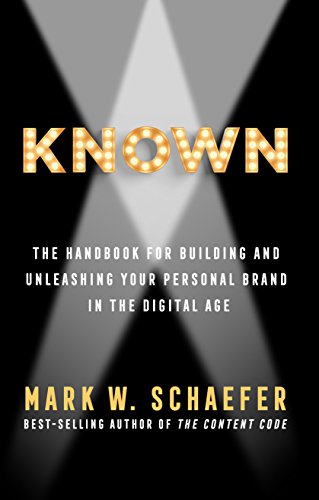Known
Being known is not the same as being famous. It’s not about having millions of fans and red carpet appearances. Being known is about having the proper authority, reputation, and audience to realize your potential and achieve your goals … whatever they might be.

You need to be known for something in a relevant space large enough for it to matter. You need to create content in a way that makes a difference and builds an audience that matters.
Becoming known requires finding a sustainable interest (your place), the right audience that accepts you (your space), and building an actionable audience.
In this tumultuous world, there are only two transferrable assets we have: our education and being “known.”
What’s the probability there will be a change in your employment status in the next five years? If you’re a relative unknown in your industry, you’ll have to compete for a new job like everybody else. But if you’re known, you’ll have an instant advantage.
A key component of becoming known is producing consistent content.
To be known, you don’t have to be a subject matter expert. But you must have the determination and patience to become one through commitment, consistency, and repeated practice.
On Writing
To have an opportunity for real authority on the web and vast reach, you need a certain type of content that has the depth and breadth to be discoverable.
Pick one platform (blog), do it really well, and build your audience there for at least a year or so. Resist the temptation to do everything and be everywhere. Focus, focus, focus on one thing, and learn to be excellent in that space.
Find the open space
Take a hard look at the content being produced in your field of interest. Try to get a sense for the uncontested spaces, and determine if there’s an under-served content opportunity there.
Building an audience
Passive audience activation
A passive emotional connection occurs when people come to know you through your content alone, typically over a long period of time. As people begin to see and enjoy your work, they progress through four phases of an emotional journey:
Awareness.
They discover your content and know you exist. Perhaps 98 percent of the people who find you will move on, but a few will stick around to move to the next phase. That’s why it’s important to constantly build awareness and attract potential new fans.
Engagement.
The new connections want to see more. They may click on a link, explore your website, comment on your blog, and even share your content with friends. It’s starting to become a two-way connection. They are learning about you and liking what they see.
Stable connection.
New fans opt-in. They subscribe to your newsletter or follow you on Facebook, LinkedIn, or another channel. Your content is adding enough value to their lives that they want to follow your work regularly. For the first time, you may know a fan exists because they’re subscribing to you. A subscription means, “I trust you and I want to see more.”
Loyalty.
Your fan not only follows you but encourages others to follow you, too. This is the elite group that’s most likely to be activated. They’ll spread your ideas, donate to your charity, or hire you to speak at an event. Your ideas and your content are becoming a part of the fabric of their lives. They can’t get enough of you.
Success rarely comes in a blinding rush. It comes gradually, like the changing of the seasons. You can’t stand in front of a maple tree and observe how its leaves change to their brilliant autumn colors. But week by week, the change does occur and the momentum builds. One way to determine if it’s time to pivot or quit is to actually measure that momentum.
The case for consistency
A year from now you could have hundreds of posts in your archives, or you could keep putting it off and have zero.
No amount of planning, prepping, hoping, wishing, or dreaming will make any difference in your potential to become known if you don’t show up on a regular basis.
Consistent effort propels you to be known, and it keeps you there.
Benefits of consistent creation
- It forces you to always have the creative juices flowing. You’re in a continuous process of brainstorming ideas that will delight your audience.
- Consistency creates committed readers. By posting reliably, your audience comes to know when they should drop-in to find something new.
- Creating content regularly helps you find your voice and develop your style. Often a sustainable interest only takes root and blooms based on feedback from your audience over time.
- The more regularly you publish, the more quickly you’ll build up your site with content that can be discovered and shared.
Action Steps to be Known:
- Develop a unique content tone or point of view.
- Find the platforms where your intended audience hangs out.
- Dominate a content type.
- Pioneer a new content form.
- Differentiate through frequency.
- Appeal to a new demographic target or region.
- Leverage relationships with influencers.
- Use curation as a strategy.